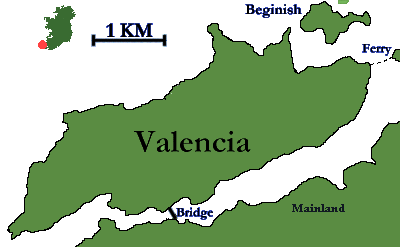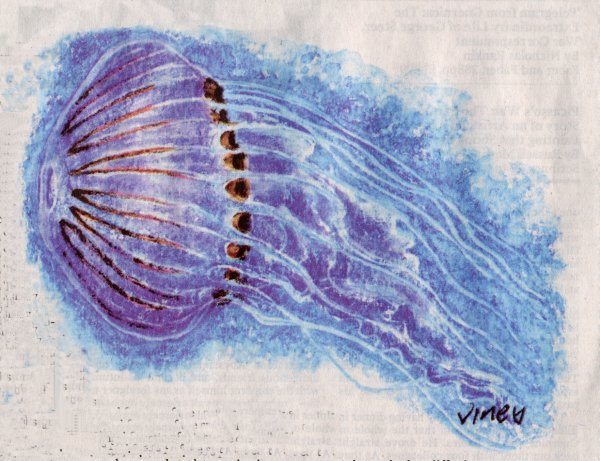

The commissioning the Celtic Explorer Ireland's new national research vessel marks a coming of age of Ireland's marine science.

The ship's impressive, hi-tech presence at the quay inin the heart of Galway connects us with the life of the deep ocean at a wholly new level of seriousness. When the Marme Institute moves into its new and glamorous research headquarters above the bay, it can look across the Atlantic to the famous Woods Hole Oceanographic Institute, in Massachusetts, with every hope of matcbimg its ambitions.
By a nice coincidence, next weekend sees a happening on Valetntia Island; Co Kerry, that reaches back a century to one of the most compelling personal stories in the history of Irish marine biology. On Friday, Saturday sad Sunday, from 3 p.m. to 7 p.m., in the old Church of Ireland in Knlghtstown, a video starting every hour will celebrate the indomnitable spirit of Maude Delap. who died in that parish in 1953.
Medusae is the work of artist Dorothy Cross who set the luminescent Ghost Ship afloat in Dún Laoghaire Harbour a few years ago and her marine biologist brother, Tom, Professor of Zoology at NUL Cork. Together, they.have spent three years exploring life, dreams and accomplishments of an extraordinary amateur naturalist. Their radio programme about her, Jellyfish was broadcast on BBC Radio 3, and the first part of Medusae, called Come into The Garden Maude was projected on to an outside wall of the National Theatre in London. The Easter screening on Valentia brings their collaboration back to its source.
Maude's life is a staking cameo of the Victorian Protestant subculture in Ireland and its enthusiasm for the study if nature. She was born at Templecrone, Co Donegal, in 1866, as the seventh of 10 children of a Church of Ireland rector, Alexander Delap, himself a keen naturalist.
Appointed rector of Valentia in 1874 (a parish that included the lightkeepers f the Skelligs), he sailed the family's belongings down the coast in his own boat, while his wife, Anna Jane, and the children travelled overland. What httle money there was went to educate the four boys, and Maude spent the rest.of her life in the house at Reenellen, with two unmarried sisters.
The Delap fnmily's early observations, sent to the Irish Naturalist helped to attract to the island, in 1895. a team pf English marine scientists. As a contribution to their study, Maude and her sister Constance rowed a currach beneath the high cliffs, trawling for plankton species with a fine net. She also fell in love with one of the young biologists (unrequitedly, as it turned out, but they corresponded for 40 years and she sent him wild violets on his birthdays)
Maude continued to depatch specimens to the Natural History Museum m Dublin including strange fish caught by trawlers, a new species of sea anemone and the skull of the rare True's beaked whale that she had rotted down ïn her asparagus bed. But her real contribution to marine biology arrived when she began breedmg jellyfish in bubbling belljars of sea-water in the rectory in a room that soon took on the distinctive smell of low tide.
By rearing mature jellyfish from their "infant" stages as hydra fixed to the sea-hed or as planktonic larvae, she was able to show for several species which young form belonged to which adult, free-swimming medusa - a considerable contribution for its time.
The slow conjuring of full-grown jellyfish (compass, moon jellies, the wonderful blue Cyanea lamarcki) from tiny eggs, blobs or planktomc whirligigs has inspired Dorothy Cross's dreamlike video sequences, in which fragments of Maude Delap's life drift and dissolve like the medusae themselves.
Her fascination as an artist, with the mysteries of Maude Dehp's life interweaves with her brother's exploration of the living mechanlcs of jellyfish, in particular the deadly tropical species Chironex Fleckeri, or box iellyfish.
Tom and Dorothy made two trips to North Queensland, Australia, for fieldwork and filming of the species. In the past century, its toxic sting has killed three times as many Australians as have died from shark attack and Tom Cross's portrait of the beast as a sharp-eyed predator, using its transparency as an effective camouflage, does much to upset my image of jellyfish as indifferent drifters.
Maudè Delap, a heroine of the margins of Irish cultural history waits. for a 'I'V docu-drama. The long-shot of the sisters rowing beneath the cliffs; her face like a mermaid's among the belljars; Maude picking violets for Mr. Browne's birthday and then, near the end, selling arum lilies from the rectory garden to add to the tiny honararium from the Natural History Museum.